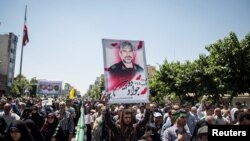Since the early June twin terror attacks in Tehran, Iranian military and intelligence organs claim to have destroyed several militant cells and foiled multiple terror plans.
A militant group in the west Iranian province of Kurdistan was demolished in the morning of June 23, according to the Public Relations Department of the Islamic Republic Revolutionary Guards Corps (IRGC).
“The [militant group] had plans to carry out operations inside Iran and create insecurity,” the statement read, adding that IRGC servicemen “identified the terrorists,” managed to kill three of them and captured one in a clash.
IRGC forces confiscated the group’s weapons and ammunition in the operation, according to Tasnim, an IRGC-affiliated news website.
The militant group, affiliated with “arrogant powers,” was “knocked down in the early hours on Friday” while intending to carry out terror acts and “causing insecurity in the country,” Sepahnews, the official news website of the IRGC, reported.
Iran's Supreme Leader Ali Khamenei and his allies frequently use the term “arrogant powers” to describe Western powers, led by the United States.
The reports did not disclose exact location of the clash, the identity of the captured person or the number of guns and ammunition seized.
The IRGC claims it established a special operation headquarters in Iranian Kurdistan and Kermanshah provinces.
The IRGC's stated mission is to coordinate local operations against anti-revolutionary forces as well as “West-affiliated armed groups” that manage to infiltrate western and northwestern parts of Iran.
Iranian authorities frequently issue statements about foiling armed attacks and arresting or killing terror suspects, but they rarely produce evidence.
IRGC’s June 23 statement is the latest report concerning deadly armed clashes in Iran after the twin terrorist attacks in Tehran earlier this month.
Seventeen civilians died and almost 50 were wounded June 7 in two nearly simultaneous terror attacks on the Iranian Parliament complex and the mausoleum of the founder of the Islamic Republic, Ayatollah Ruhollah Khomeini. All five attackers were later killed in clashes with security forces.
The Islamic State (IS) group claimed responsibility for the attacks.
Since these attacks, Iran's security forces have made frequent announcements about operations against armed groups, sometimes mentioning that alleged militants belonged to the IS group.
Last week, the official news website of Islamic Republic’s Radio and TV (IRIB) reported that an “IS team” entered west Iran through the border at Soumar, but was bombarded by security forces. Four of the infiltrated terrorists were captured, according to IRIB.
Hours later, two officials denied the veracity of IRIB's report.
Seaparately, an MP from Urmia claimed June 19 that forty IS members had been identified and arrested in West Azerbaijan province. The report was neither confirmed nor denied.
The Fars Province Justice Department also reported that six IS “elements” were tried and sentenced to prison terms on June 21.
“There has been a surge in the number of counter-terrorism operations the IRGC has launched in recent weeks,” Tasnim reported.
An IRGC unit killed Jalil Qanbarzehi, a ringleader of the Ansar al-Furqan, an Iranian Baluchi militant group, in a June 17 operation in Qasr-e Qand heights in Iran’s southeastern province of Sistan and Baluchestan, according to Tasnim.
As the IRGC lauded its forces for “demolishing terrorists”, the Intelligence Ministry reported on its own achievements in dismantling terrorists’ cells in western and southeastern parts of Iran.
In May, the ministry’s agents identified and dismantled terrorists’ cells on a daily basis, Intelligence Minister Mahmoud Alavi said in an interview with Iran Labor News Agency (ILNA).
“Nevertheless, we refrained from publicizing our operations to avoid creating a false atmosphere of panic,” he added.
Alavi, whose agents are competing with IRGC forces for credit for the recent missile attack in Syria, did not mention the incident in his latest interview. He had previously claimed that the IRGC hit IS targets in Deir ez-Zor based on information and data provided by Intelligence Ministry agents. The IRGC immediately, yet implicitly, denied the claim by emphasizing that its missiles hit IS location based on data provided by its own forces on the ground.
“Organizers of the International Quds Days rallies in Tehran have put on display the ‘Zolfaqar’ ground-to-ground missiles the IRGC employed to destroy Daesh targets in Syria’s Deir ez-Zor on June 18,” Tasnim reported.
On Sunday night, the IRGC fired six mid-range missiles from its bases in Iran’s western provinces of Kermanshah and Kurdistan at the positions of militant groups in Syria. The missile raid was made in retaliation for a recent terrorist attack in Tehran claimed by the IS group. All missiles reportedly hit their target, wreaking destruction on IS sites and killing scores of militants, according to Tasnim.
While official Iran sources have praised the attack as a ‘great success,’ the incident had varying interpretations abroad. Israel Defense Forces (IDF) Chief of Staff Gadi Eisenkot downplayed the significance of the Iranian missile strike against the Islamic State in Syria, saying “the operational achievement was less than what was reported in the media,” during a wide-ranging June 22 speech on regional security.
Though he denied IRGC’s missile efficacy, the top Israeli general acknowledged the attacks “made a statement” to the world about Iran’s preparedness to use its ballistic missiles, which the country last did in 1988.





